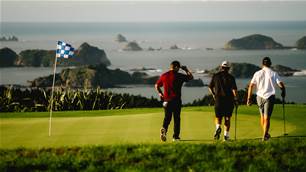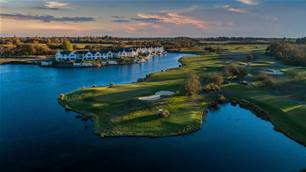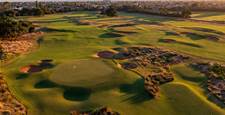The legend of how Cape Kidnappers came to be Cape Kidnappers is a tale of crossed wires.
Before the stretch of coastline was known as Cape Kidnappers, it was Te Kauwae-a-Māui – the jawbone of Māui.
Māori readings explain that native adventurer and explorer Māui fished up the North Island with a hook made from his grandmother’s jaw. That curve of land? That’s it. The hook.
The origin of “Cape Kidnappers” stems from the story of local Māori attempting to reclaim a young Tahitian they believed had been taken, only for Captain James Cook’s crew to see it as an attack and open fire. The moment passed quickly, but the name stuck: Cape Kidnappers – a lasting reminder of a tense encounter on a wild stretch of coastline.
A tense encounter is undoubtedly on the menu when you arrive at the golf facility at Cape Kidnappers, which is perched upon panoramic cliffs overlooking the Pacific; it is every piece of its tagline: golf at the edge of the earth.
Kidnappers takes your breath away when you step foot on the property. It is a magical setting and unique to the common man making his first trip to the world-renowned layout. The drive to the course traverses a gravel road through native bush. It is an authentic taste of New Zealand. If you are driving out when the sun is going down, you have every chance of spotting a Kiwi. Cape Kidnappers is home to thousands of New Zealand’s national birds.
Famed course architect Tom Doak was commissioned by American owner, the late Julian Robertson, to design a world-class layout atop the cliffs in late 2001. Robertson had the vision of a world-class golf course rolling along the dramatic Hawke’s Bay coastline. Doak delivered. The American is known for his minimalist approach and for working with the natural landscapes Mother Nature provides, rather than mass reconstruction.
He went on to create one of the most visually striking and critically acclaimed golf courses on the planet.
The course opened for play in 2004 and will be celebrating its 21st birthday this year. When Doak completed his work and the Robertsons opened the course to the public, there were expectations from the wider golfing community that Kidnappers would be a links course. As Doak tells Golf Australia magazine, this course is different from his other masterpieces.
“When we first opened Cape Kidnappers, some people seemed disappointed that it was seaside, but it wasn’t a links course – they were kind of hoping for Tara Iti because NZ doesn’t have many links, aside from Paraparaumu,” Doak explains.
“But the contours up on the Cape aren’t like that. The setting is unique. It is so much higher on the cliffs than any other course. It just gives you a different perspective on how big the world is. In the end, I’ve had the privilege to build several links courses, but there is only one Cape Kidnappers.”

You’d be surprised by how little land was moved during the construction of Kidnappers. Most of the fairways were untouched, exactly how Doak found them. He even tells a neat story about himself and his crew playing the course the week they arrived.
“I actually played most of the holes with my associates the first week we were there because the sheep had the grass chewed down to fairway height!
“That round included climbing down through the ravines on 6 and 14 to get across.
“We couldn’t play 7-8-9 because those were in the trees, and those holes were a lot of work to build – the green at the 7th was about a 15-foot cut, and the valley in front of the 7th and 9th greens has 15-plus feet of fill.
“We also had to do a lot of work short and right of the green on 4, so you could find your ball if you went for the green and came up short.

“The one thing that a lot of people don’t pick up on is that the land is generally flat, but it all tilts north toward the bay.
“So, when you are playing that direction, first, you can see the ocean – in fact, the flag is profiled against the water – and second, the green is tilting away from you.
“All of those holes are more difficult than you realise because it’s hard to get your ball to stop where you want it, and you really need to land your approach a bit short of the greens,” Doak adds.
This writer’s trip to Kidnappers started with a quick look at what the weather had in store, which meant a trip to the pro shop for some warm apparel was in order.
Kidnappers is a challenge at the best of times, but when the elements come to the party, you want to hope that your ball-striking is on song. The best advice we were given was to pay attention to your yardage book.
Right from the opening tee shot at the par-71 layout, you are forced to make a decision on club selection and think about how you are going to plot your best route to the hole. This is a common theme throughout your 18 holes at Kidnappers. The par-4 1st tips the scales at 402 metres off the championship markers. You have an open landing area that turns right and dramatically narrows. If you favour the left-hand side of the fairway, you’ll have to shape your next right-to-left to navigate the trees on the left.

From the start, you are spoiled by undulating land and green complexes. While I was rolling a few on the practice green during my last trip to Kidnappers, one of the greenskeepers politely advised me not to leave myself any putts downhill with this wind. And he was right; the course can beat you up on and around the greens, but it isn’t unfair by any stretch of the imagination. It is a test of strategy and missing in the right spots. What you see from the tee isn’t always what you get.
The first hole that captivated me was the par-3 6th, “Gulley”. A long one-shotter played over a chasmic ravine with trouble to the left and a sloping putting surface. At 206 metres off the tips, the mere mortal has a long iron – or something with stronger loft – in their hands; something in the middle of the green is a great shot. The green banks from right to left and can take your ball closer to the hole. Take your par and run here, but take in the magnificent surroundings while you are at it.
The holes on the course which Doak himself appreciates showcase the drama the landscapes provide him.
“There are a lot of other dramatic holes out there,” Doak says.
“I love standing on the 5th tee [“Split”, 384-metre par-4] and looking down the big valley to the left toward the ocean. The 4th hole [“The Rise”, 534-metre par-5)] is a favourite, and one of the holes we had to do the most work on. The par-3 8th over the treetops is one of a kind.”

The back nine is an enjoyable stretch of golf with plenty of versatility. The trademark bunkering and rolling terrain remain. The two par-3s early in the inward half are great holes. The 11th, another long one-shotter exposed to the elements, “Look Out”, is a fitting name for the 205-metre hole, as there is trouble aplenty. It plays longer than it seems. The 13th, “Al’s Ace”, is the shortest hole on the property at 119 metres. It is difficult to hold the green, especially if you don’t control the spin. Hitting it deep into the green is the smart play.
The green at 13 is very tight to the edge of the cliff. Doak says there were talks of taking it even further to the left, which is difficult to even fathom when you’re standing on the tee.
“For a long time, we were planning to build the par-3 13th hole further to the left, literally hanging off the cliff,” Doak explains.
“If we had gone for it, it would certainly be the most talked-about hole on the course and maybe in all of golf.
“But getting down to the green site and then back up to the 14th tee was going to break up the flow of the round, and the hole just started to feel out of character with everything else. So, we pulled back and built the 13th green in its current location.”
The most talked-about and polarising hole on the property is 15. It also has the best name: Pirate’s Plank. It is a gun-barrel straight, 594-metre par-5 that demands keeping it in the short grass. You have to be precise if you are attempting to combat it in two, but a lay-up asks plenty of questions equally. Playing to an “infinity green”, long is completely dead. What is exciting about this shot is that there is more than one way to get to the green; getting creative is all part of the fun. This writer felt more comfortable running one up there and rolling it onto the putting surface.

“The long 15th hole is rightly famous, and I owe that one to Julian Robertson,” Doak admits.
“I was going to shy away from running a fairway out there because it’s only 40 yards wide between the cliff and the fall away to the right, and that’s not really enough for most golfers.
“But Julian said he wanted a hole like that, even if it was ‘too hard’, which freed me up to go outside of my own comfort zone.
“We had a best-ball tournament the year after the course opened, and two of my friends vowed that they would keep the ball in play there even if it meant hitting 7-irons the whole way, and they told me they won that hole every time without even having to putt out!”
The stretch to the clubhouse is a challenge – 17 and 18 are both demanding par-4s, with the latter’s fairway funnelling down into a bowl with the green at the bottom.
Doak returned to do some renovations just post-COVID, and with minor changes, the course is thriving and has never looked better.
“There were only a few changes, and you’d have to know the course really well to pick up on them,” Doak says.
“We softened the tilt slightly on a couple of greens because the greens are faster than they used to be. And we softened the little crown in the middle of the first green because the original version was too severe to put the hole to the right of it.”
Cape Kidnappers ticks all the boxes for a bucket-list golf course. If you are a passionate golf course architecture fan, you’ll appreciate all the subtleties, quirks, and green and bunkering contours.
The million-dollar views at each and every turn are worth the price of admission alone. Combining that with first-class conditioning and friendly people, you will have a trip to savour for a lifetime.
FACT FILE
LOCATION: 446 Clifton Road, Te Awanga Hawke’s Bay 4180, New Zealand
CONTACT: proshop@capekidnappers.com; +64 6 873 1018
WEBSITE: https://www.robertsonlodges.com/the-lodges/cape-kidnappers
DESIGNERS: Tom Doak
GREEN FEES: Australian resident green fee: Summer: $700; Autumn: $445; Winter: $325; Spring: $500 (prices in NZD)
Related Articles

Review: Omaha Beach Golf Club

Touring New Zealand: The complete golfing package












